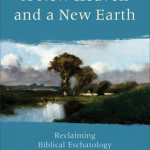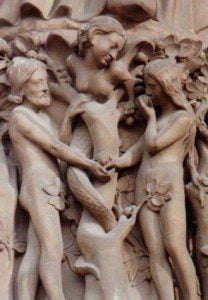 Last week I introduced a new book from the Zondervan Counterpoints series: Four Views on the Historical Adam. The contributors to the book include Denis Lamoureux, John Walton, C. John Collins, and William Barrick. The views presented range from no historical Adam (Lamoureux) to young earth creation with Adam as the unique father of the entire human race some 6000 years ago or so (Barrick). John Walton and Jack Collins fall between these two views.
Last week I introduced a new book from the Zondervan Counterpoints series: Four Views on the Historical Adam. The contributors to the book include Denis Lamoureux, John Walton, C. John Collins, and William Barrick. The views presented range from no historical Adam (Lamoureux) to young earth creation with Adam as the unique father of the entire human race some 6000 years ago or so (Barrick). John Walton and Jack Collins fall between these two views.
As we work through this book I will first put up a post presenting one of the views. This will be followed by a post that discusses the responses of the other three contributors and the rejoinder by original author along with some of my own observations. The first chapter is by Denis O. Lamoureux and this is where we start.
Dr. Lamoureux is an Associate Professor of science and religion at St. Joseph’s College in the University of Alberta (UA) in Edmonton. He received his BS in 1976 from UA, a DDS from UA in 1978 and then changed directions – receiving his MDiv and Master of Christian Studies degrees from Regent College Vancouver in 1987 and his Ph.D. in Interdisciplinary Theology–Science and Religion from University of St. Michael’s College in the University of Toronto, in 1991. Returning once again to science he received a Ph.D. from UA in Oral Biology–Dental Development and Evolution. Several years ago I posted on Denis Lamoureux’s book Evolutionary Creation (between November 2010 and January 2011). His chapter in the current book is a condensation of the much more detailed argument put forth in the larger book.
 Dr. Lamoureux’s position on the relationship between science and scripture centers on the Message-Incident Principle. The ancient views of science, including ancient views of origins are incidental to the theological truths conveyed in scripture. This can be expressed as accommodation – God accommodated his message to the understanding of his people. He did not introduce new science in scripture only to be understood many millenia later. We do not find and, upon reflection, should not expect concordance between our current science and cosmology and that reflected incidentally in scripture.
Dr. Lamoureux’s position on the relationship between science and scripture centers on the Message-Incident Principle. The ancient views of science, including ancient views of origins are incidental to the theological truths conveyed in scripture. This can be expressed as accommodation – God accommodated his message to the understanding of his people. He did not introduce new science in scripture only to be understood many millenia later. We do not find and, upon reflection, should not expect concordance between our current science and cosmology and that reflected incidentally in scripture.
There are many examples that can be used to illustrate this principle. One example used by Lamoureux in this chapter is the last portion of the great Christological hymn found in Philippians 2:9-11.
Therefore God exalted him to the highest place
and gave him the name that is above every name,
that at the name of Jesus every knee should bow,
in heaven and on earth and under the earth,
and every tongue acknowledge that Jesus Christ is Lord,
to the glory of God the Father.
The line “in heaven and on earth and under the earth” reflects the ancient view of a three tiered universe where “under the earth” uses a word καταχθόνιος that refers to those departed souls who dwell in the world below, that is in the underworld. This verse indicates that Paul, along with his contemporaries, accepted the 3-tier universe. According to Lamoureux:
In the case of Philippians 2:10-11, the Message of Faith reveals the lordship of Jesus over the entire creation, and the incidental ancient science is the 3-tier universe. (p. 50)
Another example of the presence of ancient science or cosmology in scripture is found in the description of the second and fourth days of creation in Genesis 1. The firmament that God puts in place to separate the waters above from the waters below was viewed by the ancient Israelite audience in common with the other ancient Near Eastern cultures as a solid boundary structure. On day four the greater and lesser lights and the stars were placed in the firmament. The concept of the relationship between earth, sky, stars, sun, moon, was completely different from the understanding we have today.
 The sun god tablet or tablet of Shamash dating from the 9th century BC illustrates the firmament (bottom layer) with the stars, waters, and then the throne of Shamash in the heavens. Dr. Lamoureux points out that this structure is also reflected in Psalm 104:2-3.
The sun god tablet or tablet of Shamash dating from the 9th century BC illustrates the firmament (bottom layer) with the stars, waters, and then the throne of Shamash in the heavens. Dr. Lamoureux points out that this structure is also reflected in Psalm 104:2-3.
The Lord wraps himself in light as with a garment;
he stretches out the heavens like a tent
and lays the beams of his upper chambers on their waters.
According to Lamoureux:
Now what are we to do with these passages in Genesis 1 about the creation of the heavens? The Message-Incident Principle allows us to appreciate that the Holy Spirit accommodated to the level of the ancient Hebrews and used the science-of-the-day in order to reveal the inerrant spiritual truth that God created the visually dominant blue “structure” overhead with the sun, moon, and stars “embedded” in it. The Message of Faith remains steadfast for us today: the Creator made the visual phenomenon of the blue sky and all the heavenly bodies. (p. 53)
These three examples (the 3-tier universe in Philippians 2, the firmament in Genesis 1, a and the upper chambers on the waters in Psalm 104) only scratch the surface. Many (many) more examples of ancient “scientific” understanding expressed in the text of Scripture could be given. Some we hardly notice, assuming them to be figurative when they are not, others are obscured by the word choice of the translators. Taken together they should help us to understand the nature and form of the text of Scripture. The ancient science, when it appears, is not an “error” but the way that God has accommodated his message to the understanding of finite human beings.
So what about Adam? Denis Lamoureux believes that the same principle of accommodation applies to the description of the origin of life and the creation of Adam. The Message of Faith in Genesis 1 is that God is the Creator of life, but the unique creation of kinds and even the words used to express this (the land produces living creatures in v. 24 as it produces vegetation in v. 11 – not exactly the way we think about the creation of animals) are incidental.
The de novo creation of Adam from the dust is another example of ancient “science of origins” in the text. The creation of humans from dust or clay is found in a number of ancient Near Eastern texts. The de novo creation of humans reflects an ancient phenomenological understanding of origins. The Message of Faith is that God formed, loves, and cares for humanity.
Turning to the New Testament references, Lamoureux believes that Paul, with an ancient phenomenological view of origins and immersed in the Scriptures, thought Adam was a unique individual. However, the conferment argument (that Paul’s belief in Adam confers (or requires) a historical Adam) is challenged by the 3-tier universe of Philippians 2 and by the wide-spread occurrence of ancient understandings of “science” throughout scripture. Few would argue that Paul’s understanding of cosmology or geography confers that view on the nature of reality.
The second argument that is often raised is consistency – because Paul compares Adam and Jesus consistency demands that either both or neither are historical individuals. The consistency argument fails to distinguish the person of Jesus witnessed by the disciples and many others from the nature of the text of Genesis 2-3 which describes events that predate the written accounts by millenia. Lamoureux also points out that it is the name of Jesus to which every knee in heaven, on earth, and in the underworld should bow. Few would think that consistency requires belief in both Jesus and a 3-tier universe.
So when it comes to Adam, Lamoureux concludes:
The Divine Book of Words reveals that humans are the only creatures who bear the image of God, and only humans are sinful. I suspect that the manifestation of these spiritual realities coincides with the appearance of behaviorally modern humans about 50,000 years ago. (p. 64)
…
To conclude, I do not believe that there ever was a historical Adam. Yet he plays a pivotal role in Holy Scripture. Adam functions as the archetype of every man and woman. …
Adam’s story is our story. … To understand who we truly are, we must place ourselves in the garden of Eden. The nonhistorical first Adam is you and me. But the Good News is that the historical Second Adam died for our sins and frees us from the chains of sin and death. Amen. (p. 65)
In the next post on the book we will look at the responses offered by John Walton, Jack Collins, and William Barrick to Denis Lamoureux’s view.
What is your impression of Lamoureux’s argument?
Does the Message-Incident Principle make sense?
Should we expect scientific concordance in the pages of Scripture? If so when?
If you wish to contact me directly you may do so at rjs4mail [at] att.net.
If interested you can subscribe to a full text feed of my posts at Musings on Science and Theology.











